- Clone
- QA20A70 (See other available formats)
- Regulatory Status
- RUO
- Other Names
- LTB4R, BLT1, LTBR1, LTB4R1, Leukotriene B4 Receptor
- Isotype
- Mouse IgG2a, κ
- Ave. Rating
- Submit a Review
- Product Citations
- publications
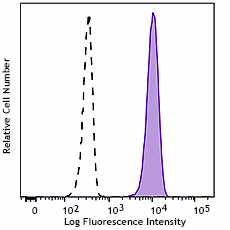
-

Human peripheral blood granulocytes were stained with purified anti-human BLTR recombinant (clone QA20A70) (filled histogram) or purified mouse IgG2a, κ isotype control (open histogram), followed by FITC goat anti-mouse IgG.
| Cat # | Size | Price | Quantity Check Availability | Save | ||
|---|---|---|---|---|---|---|
| 383602 | 100 µg | $385 | ||||
Leukotriene B4 receptor (BLTR or LTB4R-1), is a G protein-coupled receptor. It functions as a leukocyte chemoattractant. It activates the G1 family of the G proteins to mediate chemotaxis and it also uses G proteins to mediate cytotoxic activities. BLTR plays an important role in the recruitment and retention of leukocytes, primarily eosinophils.
Product DetailsProduct Details
- Verified Reactivity
- Human
- Antibody Type
- Recombinant
- Host Species
- Mouse
- Formulation
- Phosphate-buffered solution, pH 7.2, containing 0.09% sodium azide
- Preparation
- The antibody was purified by affinity chromatography.
- Concentration
- 0.5 mg/mL
- Storage & Handling
- The antibody solution should be stored undiluted between 2°C and 8°C.
- Application
-
FC - Quality tested
- Recommended Usage
-
Each lot of this antibody is quality control tested by immunofluorescent staining with flow cytometric analysis. For flow cytometric staining, the suggested use of this reagent is ≤ 0.5 µg per million cells in 100 µL volume. It is recommended that the reagent be titrated for optimal performance for each application.
- RRID
-
AB_2927873 (BioLegend Cat. No. 383602)
Antigen Details
- Structure
- G protein-coupled receptor
- Distribution
-
Granulocytes, Monocytes, Dendritic cells
- Function
- Leukocyte chemoattractant
- Ligand/Receptor
- Leukotriene B4
- Cell Type
- Basophils, Epithelial cells, Granulocytes, Leukocytes, Mast cells, Monocytes, Neutrophils
- Biology Area
- Cell Biology, Immunology
- Molecular Family
- GPCR, Innate Immune Signaling
- Antigen References
-
- Yokomizo Y, et al. 1997. Nature. 387:620-4
- Lundeen KA, et al. 2006. J Immunol. 177:3439-47
- Gene ID
- 1241 View all products for this Gene ID
- UniProt
- View information about BLTR on UniProt.org
Other Formats
View All BLTR Reagents Request Custom Conjugation| Description | Clone | Applications |
|---|---|---|
| Purified anti-human BLTR Recombinant Antibody | QA20A70 | FC |
| PE anti-human BLTR Recombinant Antibody | QA20A70 | FC |
| APC anti-human BLTR Recombinant Antibody | QA20A70 | FC |
| FITC anti-human BLTR Recombinant Antibody | QA20A70 | FC |
| PerCP/Cyanine5.5 anti-human BLTR Recombinant Antibody | QA20A70 | FC |
Compare Data Across All Formats
This data display is provided for general comparisons between formats.
Your actual data may vary due to variations in samples, target cells, instruments and their settings, staining conditions, and other factors.
If you need assistance with selecting the best format contact our expert technical support team.
-
Purified anti-human BLTR Recombinant Antibody
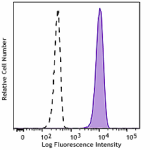
Human peripheral blood granulocytes were stained with purifi... -
PE anti-human BLTR Recombinant Antibody
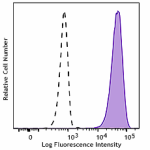
Human peripheral blood granulocytes were stained with anti-h... -
APC anti-human BLTR Recombinant Antibody
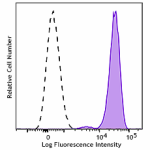
Human peripheral blood granulocytes were stained with anti-h... -
FITC anti-human BLTR Recombinant Antibody
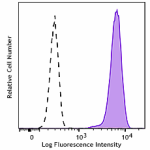
Human peripheral blood granulocytes were stained with anti-h... -
PerCP/Cyanine5.5 anti-human BLTR Recombinant Antibody
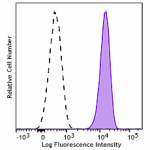
Human peripheral blood granulocytes were stained with anti-h...
 Login/Register
Login/Register 







Follow Us